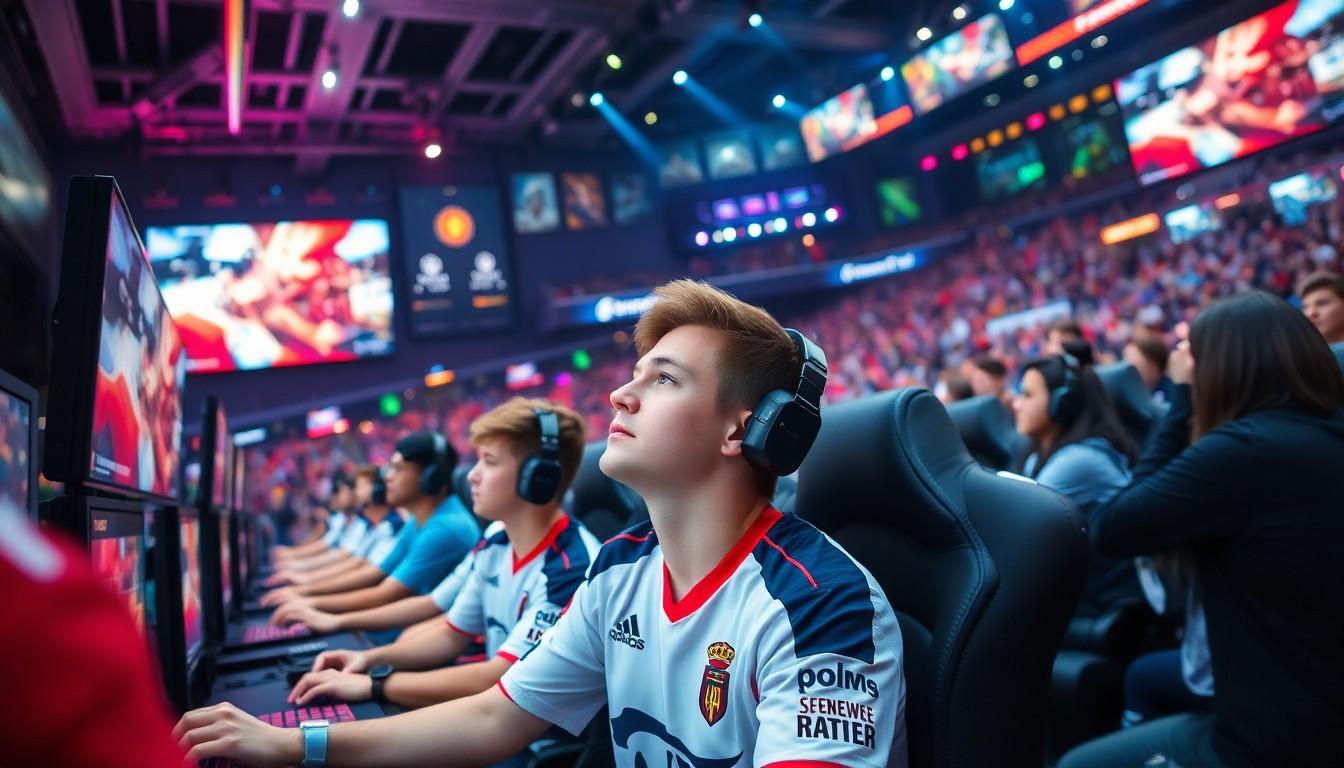The esports industry is booming faster than a gamer can hit the “respawn” button. Once considered a niche hobby, it’s now a multi-billion dollar powerhouse that’s capturing the attention of investors, brands, and fans alike. With thrilling tournaments packed with nail-biting action and players raking in cash like it’s their day job—because it is—the question isn’t whether esports is worth something, but how much it’s worth.
esports industry worth
The esports industry represents a dynamic sector witnessing exponential growth over the last decade. It has evolved into a global phenomenon with an estimated value of over $1.5 billion in 2023, drawing substantial investment from major corporations and brands alike. Streaming platforms, sponsorship deals, and media rights contribute significantly to this valuation.
Competitive gaming events attract millions of viewers, both online and offline. They generate considerable revenue through ticket sales, merchandise, and advertising. Tournaments such as ‘The International’ for Dota 2 and the ‘League of Legends World Championship’ highlight the immense popularity and financial stakes involved.
Demographic trends indicate a diverse audience, predominantly composed of younger individuals aged 18 to 34. Gamers from various backgrounds engage in this entertainment form, which bridges gaps across different cultures. Companies recognize this shifting landscape and tailor marketing strategies aimed at this vibrant demographic.
Investment in esports teams and leagues reflects broader trends within the sports sector. Valuations for top franchises often exceed hundreds of millions, showcasing their potential profitability. Brands like Intel and Coca-Cola have already established sponsorships, highlighting the industry’s mainstream acceptance.
Future projections signal continued growth for the esports industry. Analysts predict its worth could surpass $3 billion by 2025, driven by increasing viewership and involvement from traditional sports organizations. Expansion into new markets further fuels this upward trajectory, with countries in Asia and Europe exhibiting strong engagement levels.
The esports ecosystem includes professional teams, gaming publishers, and tournament organizers. Collaboration among these entities fosters innovation and enhances the overall experience for fans, ensuring sustained interest and participation.
Current Market Value

The esports industry holds a market value exceeding $1.5 billion in 2023. Significant investments from major corporations and brands have become essential components of this valuation.
Statistics and Figures
In recent years, revenue streams from streaming platforms, sponsorships, and media rights have surged. Competitive gaming events attract viewership in the millions. For example, ‘The International’ for Dota 2 and the ‘League of Legends World Championship’ generate extensive income through ticket sales and merchandise. The average revenue generated per event varies but can reach tens of millions. A considerable percentage of the audience, around 65%, consists of young adults aged 18 to 34, making them a key demographic for marketing strategies.
Growth Trends
Analysts project the esports industry’s worth could surpass $3 billion by 2025. Factors driving this growth include increasing viewership and engagement from traditional sports organizations. Brands such as Intel and Coca-Cola highlight the industry’s mainstream acceptance through sponsorships. Investment in esports teams and leagues mirrors broader sports sector trends. The rise of professional gaming has established top franchises valued at hundreds of millions, contributing significantly to the total market valuation. Collaborations among teams, gaming publishers, and tournament organizers promote ongoing innovation and participation.
Factors Influencing Industry Worth
Several factors significantly influence the worth of the esports industry. Key drivers include sponsorship revenues, advertising income, and the proliferation of media rights and streaming platforms.
Sponsorship and Advertising Revenue
Sponsorship spending in esports has skyrocketed, reflecting brands’ growing interest. Major companies invest heavily in partnerships with esports organizations and tournaments. Estimates suggest sponsorship and advertising contribute over 60% of the total revenue. Brands leverage esports to reach young, engaged audiences, driving impactful marketing strategies. Tournaments attract sponsors eager to gain visibility through team jerseys, event branding, and promotional activities.
Media Rights and Streaming Platforms
Media rights represent another crucial revenue source in the esports ecosystem. Streaming platforms like Twitch and YouTube Gaming enable significant reach, offering lucrative contracts for live event coverage. These platforms generate multi-million dollar deals for exclusive streaming rights. Recent data indicates that around 50% of esports revenue derives from media rights agreements. Engaging content and large viewership provide additional incentives for brands and advertisers to invest in this rapidly expanding market.
Regional Insights
The esports industry exhibits varying dynamics across regions, reflecting distinct consumer behaviors and market opportunities.
North America
North America stands out as a significant market, contributing over $500 million to the global esports revenue. Major leagues like the Overwatch League and League of Legends Championship Series attract substantial viewership and sponsorship deals. Brands increasingly recognize the value of targeting the 18 to 34 demographic, which represents a large portion of esports fans. Engaging streaming platforms such as Twitch play a crucial role, generating multi-million dollar revenue through advertising and subscriptions. Sponsorship spending from corporations like Pepsi and Red Bull further boosts the sector, with about 60% of revenue stemming from brand partnerships. This environment fosters a strong competitive edge, positioning North America as a leading force in the esports landscape.
Asia-Pacific
The Asia-Pacific region leads the esports market with a valuation surpassing $800 million, driven by countries like China and South Korea. Competitive gaming events attract tens of millions of viewers, significantly impacting local economies. The popularity of mobile gaming also enhances engagement, as mobile esports titles draw large audiences and sponsorship opportunities. Streaming platforms such as Douyin and Huya cater to localized content, resulting in lucrative media rights agreements. In this region, players like Tencent and NetEase dominate the gaming landscape, amplifying investment in esports. As fan engagement continues to rise, brands increasingly explore partnerships, illustrating the region’s potential to shape the future of the industry.
Future Projections
The esports industry is poised for remarkable growth. Analysts predict the market value could exceed $3 billion by 2025. Rapidly increasing viewership and traditional sports organizations’ engagement drive this expansion.
Emerging Markets
Emerging markets play a crucial role in the esports landscape. Regions such as Latin America and Africa present vast opportunities for growth. In Latin America, the presence of increasingly popular titles, such as Free Fire, attracts significant player bases and viewers. The Middle East also shows great potential, with major events gaining traction and fostering local talent development. As infrastructure improves, investments in local tournaments are likely to surge, creating more business opportunities. Data reflects that esports viewership in these areas is growing at an impressive rate, making them essential for future industry expansion.
Potential Challenges
Potential challenges could impede the esports industry’s trajectory. Market saturation may arise as competitors flood the space, leading to a struggle for viewers’ attention. Regulatory issues present another concern, particularly in regions with strict gambling laws impacting sponsorships and team funding. A reliance on major streaming platforms might restrict growth, making diversification necessary for sustainability. Additionally, maintaining engagement is vital as audience preferences shift rapidly, necessitating ongoing innovation. These factors underscore the need for strategic approaches to navigate the competitive landscape effectively.
landscape of entertainment and marketing
The esports industry’s impressive growth trajectory is reshaping the landscape of entertainment and marketing. With a market value exceeding $1.5 billion in 2023 and projections suggesting it could surpass $3 billion by 2025, the opportunities for brands and investors are vast.
Engagement from fans and lucrative sponsorship deals are driving this expansion, making esports a focal point for reaching younger demographics. As the ecosystem evolves, collaboration among teams, publishers, and sponsors will be crucial for sustaining interest and innovation.
Emerging markets and regional dynamics further enhance the industry’s potential, ensuring that esports remains a vibrant and influential segment of the global economy. The future looks bright for esports as it continues to capture the hearts of millions worldwide.

